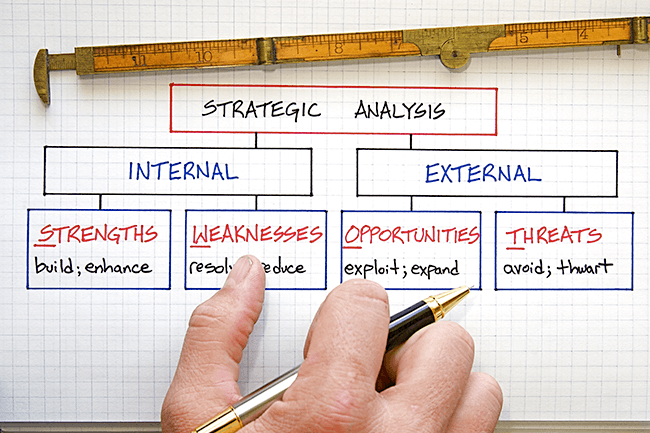Maximizing Business Potential with SWOT Analysis Templates

Key Takeaways
A lot can go wrong while you’re giving a presentation. You may forget what you want to say. You may have put your slides out of order.
- Fundamentals of SWOT Analysis: Understanding the core elements of Strengths, Weaknesses, Opportunities, and Threats is crucial for strategic business planning.
- Digital Advancements: The evolution of SWOT analysis into digital platforms like online whiteboards has enhanced its efficiency and collaborative potential.
- SWOT in Various Business Scenarios: Adapting SWOT analysis for different business models, from startups to established companies, and its application across various industries.
- Designing Effective SWOT Templates: Essential features and best practices for creating interactive and effective SWOT templates for digital use.
- Real-World Applications: Insights from case studies and expert opinions on the practical application and effectiveness of SWOT analysis in diverse business settings.
- SWOT vs. Other Tools: Understanding the situational appropriateness of SWOT analysis compared to other strategic tools.
- Ethical and Cultural Considerations: The importance of ethical practices and cultural sensitivity in conducting SWOT analysis, especially in global business contexts.
- Data-Driven SWOT Analysis: Incorporating statistical insights for a more objective and comprehensive strategic planning process.
- Continuous Strategic Evaluation: Emphasizing SWOT analysis as an ongoing process for maintaining relevance and effectiveness in a dynamic business environment.
- Further Learning Resources: Encouraging readers to explore additional resources for a deeper understanding of SWOT analysis and its applications.
Maximizing Business Potential with SWOT Analysis Templates
What’s the best way to make sure that this doesn’t happen? You need to practice a ton before you give your presentation. Consider trying out the following methods as you practice.
The Role of SWOT Analysis in Business Strategy
SWOT Analysis, an essential tool for business strategizing, involves examining four key aspects: Strengths, Weaknesses, Opportunities, and Threats. By identifying these elements, companies can create more robust business strategies. Strengths and weaknesses are internal factors, such as resources and processes, while opportunities and threats are external, influenced by the market and competition. Utilizing SWOT Analysis templates simplifies this process, offering a structured approach to evaluate these factors effectively.
Benefits of Online Whiteboards for SWOT Analysis
Online whiteboards enhance the SWOT analysis process significantly. They offer real-time collaboration, allowing team members, regardless of their location, to contribute and view updates instantly. This interactive platform supports visual engagement, making it easier to categorize and prioritize items within the SWOT framework. HuddleIQ’s online whiteboard facilitates a dynamic and flexible environment for conducting SWOT analysis, making it an indispensable tool for modern businesses.
Historical Evolution of SWOT Analysis in Business
Origins of SWOT Analysis: The concept of SWOT analysis dates back to the 1960s, developed at the Stanford Research Institute. Initially designed as a business planning tool, it helped organizations align their internal resources and capabilities with external opportunities and threats.
Evolution into the Digital Age: As technology advanced, SWOT analysis transitioned from traditional pen-and-paper methods to digital platforms. The advent of online tools and software brought about a transformative change, offering businesses the flexibility and efficiency of conducting analyses digitally.
Key Concepts of SWOT Analysis
Understanding Strengths, Weaknesses, Opportunities, and Threats: Strengths refer to what an organization excels at, its unique resources, or competitive advantages. Weaknesses are areas where the business may be lacking or areas that need improvement. Opportunities can arise from market trends, economic shifts, or changes in technology. Threats include competition, regulatory changes, or negative market trends.
Designing Effective SWOT Analysis Templates for Online Whiteboards
Interplay of SWOT Components in Business Strategy: The effective interplay of these components is crucial. Leveraging strengths and opportunities while addressing weaknesses and mitigating threats forms the crux of a successful business strategy. HuddleIQ’s guide on strategic planning templates provides insights into integrating these components into a cohesive strategy.
Essential Features of Digital SWOT Templates
Digital SWOT templates should be user-friendly and customizable to fit various business needs. Key features include interactive elements like drag-and-drop, easy categorization, and the ability to annotate and edit in real-time. These templates should also support data visualization, making it easier to identify and analyze trends and patterns.
Best Practices for Creating Interactive SWOT Templates
To create effective SWOT templates, focus on simplicity and clarity. Templates should guide users through the analysis process seamlessly, with distinct sections for each SWOT component. Including tips or prompts in the template can help users think critically about each category.
Real-World Examples of SWOT Analysis Success
Several businesses across industries have successfully utilized SWOT analysis to steer their strategies. For instance, a tech startup identified its agile innovation as a strength, but limited market presence as a weakness. By recognizing these factors, the company capitalized on emerging tech trends (opportunity) while strategizing against established competitors (threat).
Lessons Learned from SWOT Analysis Implementations
Key lessons include the importance of objectivity in identifying strengths and weaknesses and the need to stay informed about external factors that could present opportunities or threats. Regularly updating the SWOT analysis ensures that strategies remain relevant and effective.
Translating SWOT Analysis into Business Strategies
After completing a SWOT analysis, the next step is to develop strategies that leverage strengths and opportunities while addressing weaknesses and threats. For example, a company with strong research capabilities (strength) might invest more in R&D to capitalize on a growing market trend (opportunity) while improving its marketing strategies to counteract its low brand visibility (weakness).
Case Studies on Effective SWOT Interpretation
Case studies often reveal how businesses transform insights from SWOT analysis into actionable strategies. For instance, a retail company identified an opportunity in e-commerce expansion and used its robust supply chain (strength) to effectively compete against online retail giants (threat).
SWOT Analysis in Startups vs. Established Companies
Startups might emphasize innovation and adaptability as strengths, while established companies might focus on market presence and financial stability. The approach to opportunities and threats also differs, with startups often being more risk-tolerant.
Industry-Specific Applications of SWOT Analysis
Different industries prioritize different aspects of SWOT. For example, in tech, innovation and technological advancement are often key strengths and opportunities, while in retail, customer loyalty and brand reputation might take precedence.
Integrating SWOT Analysis into Business Planning
Incorporating SWOT analysis into regular business planning helps in continuously aligning strategies with internal capabilities and external market conditions. This integration fosters a proactive rather than reactive approach to business challenges and opportunities.
Using SWOT Analysis for Decision Making and Strategic Planning
SWOT analysis serves as a foundational tool for decision-making, helping leaders evaluate options in the context of their business’s strengths, weaknesses, opportunities, and threats. For instance, a company might decide against entering a new market (opportunity) if it identifies significant operational weaknesses that need addressing first.
Utilizing SWOT Analysis for Market Prediction
SWOT analysis can be a powerful predictive tool when used to analyze market trends and consumer behaviors. For example, a company may identify a growing trend in sustainable products (opportunity) and leverage its eco-friendly production processes (strength) to meet this demand, while being aware of changing regulatory environments (threat).
Adapting Business Strategies Based on SWOT Forecasting
Adapting business strategies based on SWOT forecasting involves regularly updating the SWOT analysis to reflect the changing market and internal business conditions. This ensures that the company remains agile and can pivot or adapt strategies in response to emerging threats or opportunities.
Interviews with Industry Leaders on SWOT Analysis
Interviews with industry leaders often reveal the practical impacts of SWOT analysis on business strategy. Leaders emphasize the importance of a thorough and honest SWOT analysis in uncovering hidden opportunities and potential risks.
Expert Opinions on the Effectiveness of SWOT Analysis
Experts generally agree on the effectiveness of SWOT analysis in providing a clear, structured framework for strategic planning. However, they also caution against the oversimplification of issues and recommend combining SWOT with other analytical tools for a comprehensive strategy.
Pros and Cons of SWOT Analysis Compared to Other Methods
While SWOT analysis offers simplicity and a broad overview of the business environment, it may lack the specificity and quantitative analysis provided by other tools like PESTLE or Porter’s Five Forces. It’s best used in conjunction with these tools for a more detailed strategic analysis.
Situational Appropriateness of SWOT Analysis vs. Other Tools
The appropriateness of SWOT analysis depends on the specific needs of the business and the context of the situation. It is particularly useful in the initial stages of strategy development or when a quick, general overview is required.
Assessing the Benefits of SWOT Analysis in Business
SWOT analysis is beneficial for its ease of use, flexibility, and ability to provide a quick overview of a company’s position. It fosters collaborative strategic planning and can be adapted to any organization, regardless of size or sector.
Understanding the Limitations and Challenges of SWOT Analysis
One of the main limitations of SWOT analysis is its inherent subjectivity, which can lead to biases or misinterpretations. Additionally, it does not prioritize elements within each category, which can lead to a lack of focus in strategy development.
Common Misconceptions and Their Clarifications
There are several myths surrounding SWOT analysis, such as it being only for large corporations or too simplistic for complex business environments. However, SWOT is highly adaptable and can provide valuable insights for businesses of all sizes and complexities when used correctly.
Separating Fact from Fiction in SWOT Analysis
Another common misconception is that SWOT analysis can be done quickly without in-depth thought. In reality, effective SWOT analysis requires thorough research and careful consideration of each factor to ensure accurate and beneficial results.
Addressing Common Queries About SWOT Analysis
Common questions include how often SWOT analysis should be conducted and how to effectively involve team members in the process. Regular updates, at least annually or when significant changes occur, are recommended, and involving diverse team perspectives ensures a comprehensive analysis.
Expert Responses to SWOT Analysis Questions
Experts emphasize the importance of objectivity and the need to back up SWOT elements with data and research. They also recommend using digital tools like online whiteboards for collaborative and interactive SWOT sessions, as seen in HuddleIQ’s online whiteboard features.
- Gather a diverse team for broad perspectives.
- Clearly define objectives of the analysis.
- Conduct thorough internal and external research.
- Use an online whiteboard or SWOT template for organization.
- Brainstorm and list strengths, weaknesses, opportunities, and threats.
- Review and refine the lists, ensuring they are specific and actionable.
- Develop strategies based on the SWOT analysis findings.
Checklists and Tips for Successful SWOT Analysis Implementation
Tips include keeping the analysis focused and relevant, avoiding vague statements, and prioritizing elements in each category based on their impact on business objectives. HuddleIQ’s strategic planning templates can be a useful resource in this process.
Methods for Self-Evaluation Using SWOT Analysis
Self-assessment through SWOT involves a critical evaluation of personal strengths, weaknesses, opportunities for growth, and potential external threats to career development. This can be particularly useful for individual professionals and entrepreneurs.
Tools to Enhance SWOT Analysis for Personal and Organizational Growth
Digital tools like online whiteboards enhance the SWOT process by providing a visual and collaborative platform. This can be particularly effective for teams in organizations to collectively assess and strategize on organizational strengths, weaknesses, opportunities, and threats.
Ethics in Conducting SWOT Analysis
Ethical considerations in SWOT analysis involve ensuring that the data used is accurate and obtained through legitimate means. It’s crucial to respect confidentiality and privacy, especially when dealing with sensitive internal information or data about competitors and market trends.
Cultural Sensitivity in Global Business Analysis
Cultural sensitivity is key, particularly for businesses operating in international markets. Understanding and respecting cultural differences can significantly impact the accuracy of the Opportunities and Threats sections of SWOT, which are heavily influenced by external, market-based factors.
Anecdotes from Business Leaders on SWOT Analysis
Many business leaders share stories of how SWOT analysis helped them navigate challenging times or capitalize on unforeseen opportunities. These personal stories often highlight the practical benefits and real-world applications of SWOT in various business scenarios.
Personal Journeys and Insights Gained from SWOT Analysis
Professionals from different industries often recount how SWOT analysis provided clarity and direction in their career paths or business ventures, helping them make informed decisions and strategize effectively in competitive environments.
Data-Driven Decision Making with SWOT
Incorporating statistical data into SWOT analysis enhances its effectiveness, allowing for more objective and quantifiable insights. This approach helps in validating the Strengths and Weaknesses internally and understanding Opportunities and Threats in the market with solid data.
Analyzing Business Statistics through the Lens of SWOT Analysis
Using statistical tools and techniques to analyze business performance and market trends can provide a more comprehensive view of the SWOT elements. This data-driven approach leads to more accurate and actionable strategic planning.
Summarizing the Importance of SWOT Analysis in Business
SWOT analysis is a versatile and valuable tool for strategic planning, offering insights into a business’s internal capabilities and external environment. When conducted effectively, it can guide businesses in making informed decisions, identifying growth opportunities, and mitigating risks.
Final Thoughts on Maximizing Business Potential with SWOT
To fully leverage the benefits of SWOT analysis, businesses should approach it as an ongoing process rather than a one-time activity. Continuously updating and revisiting the SWOT analysis ensures that strategies remain relevant and effective in a dynamic business landscape.
As we conclude our comprehensive exploration of SWOT analysis, it’s clear that this tool remains indispensable in modern business strategy. For further insights and practical applications, visit HuddleIQ’s extensive resource library, which includes guides on managing remote teams and using technology in remote teaching, complementing the strategic insights provided by SWOT analysis.














